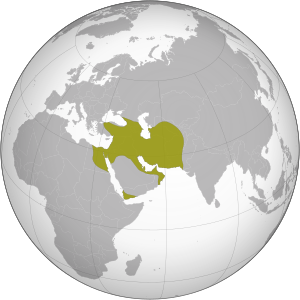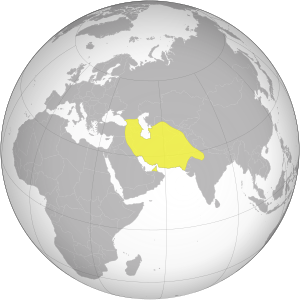Persian Empire

Persian Empire in the Achaemenid era, 6th century BC

Tomb of Cyrus the Great, founder of the Achaemenid Empire (the first Persian Empire) in the 6th century BC

Taq Kasra (Arch of Ctesiphon), symbol of the Sasanian Empire, 3rd century AD
The Persian Empire (Persian: شاهنشاهی ایران, translit. Šâhanšâhiye Irân, lit. 'Imperial Iran') refers to any of a series of imperial dynasties that were centred in Persia/Iran from the 6th century BC Achaemenid Empire era to the 20th century AD in the Qajar dynasty era.
Contents
1 Achaemenids
2 Parthians and Sasanians
3 Safavids
4 List of the dynasties described as a Persian Empire
5 See also
6 References
6.1 Citations
6.2 Sources
7 External links
Achaemenids
The first dynasty of the Persian Empire was created by Achaemenids, established by Cyrus the Great in 550 BC with the conquest of Median, Lydian and Babylonian empires.[1][2] It covered much of the Ancient world when it was conquered by Alexander the Great. Persepolis is the most famous historical site related to Persian Empire in the Achaemenid era and it has been a UNESCO World Heritage Site since 1979.
Parthians and Sasanians
From 247 BC to 224 AD, Persia was ruled by the Parthian Empire, which supplanted the Hellenistic Seleucid Empire, and then by the Sassanian Empire, which ruled up until the mid-7th century.[3]
The Persian Empire in the Sasanian era was interrupted by the Arab conquest of Persia in 651 AD, establishing the even larger Islamic caliphate, and later by the Mongol invasion. The main religion of ancient Persia was the native Zoroastrianism, but after the seventh century, it was slowly replaced by Islam which achieved a majority in the 10th century.
Safavids

Shah Abbas I, the most powerful king of the Safavid dynasty
The Safavid Empire was the first Persian Empire established after the Arab conquest of Persia by Shah Ismail I. From their base in Ardabil, the Safavid Persians established control over parts of Greater Persia/Iran and reasserted the Persian identity of the region, becoming the first native Persian dynasty since the Sasanian Empire to establish a unified Persian state.
Literature, art and architecture flourished in the Safavid era once again, and it is often cited as the "rebirth of the Persian Empire". Safavids also announced Shia Islam as the official religion in the empire versus the Sunni Islam in the neighbouring Ottoman Empire.
List of the dynasties described as a Persian Empire
Achaemenid Empire (550–330 BC)
Sasanian Empire (224–651 AD)
Safavid dynasty (1501–1736 AD)
Afsharid dynasty (1736–1796 AD)
Qajar dynasty (1785–1925 AD)

Extent of the first Persian Empire, the Achaemenid Empire

Extent of the Sasanian Empire in 621

The maximum extent of the Safavid Empire under Shah Abbas I

Extent of the Afsharid Empire under Nader Shah
See also
- List of monarchs of Persia
- Iranian monarchy
- List of Iranian dynasties and countries
- Persia
- Iranian peoples
- Persian people
- List of tombs of Iranian people
References
Citations
^ Herodotus (2015) [2014]. "Halicarnassus". The Histories. Penguin Classics Deluxe (Reprint ed.). London: Penguin Classics. pp. (page needed). ISBN 978-0143107545..mw-parser-output cite.citation{font-style:inherit}.mw-parser-output .citation q{quotes:"""""""'""'"}.mw-parser-output .citation .cs1-lock-free a{background:url("//upload.wikimedia.org/wikipedia/commons/thumb/6/65/Lock-green.svg/9px-Lock-green.svg.png")no-repeat;background-position:right .1em center}.mw-parser-output .citation .cs1-lock-limited a,.mw-parser-output .citation .cs1-lock-registration a{background:url("//upload.wikimedia.org/wikipedia/commons/thumb/d/d6/Lock-gray-alt-2.svg/9px-Lock-gray-alt-2.svg.png")no-repeat;background-position:right .1em center}.mw-parser-output .citation .cs1-lock-subscription a{background:url("//upload.wikimedia.org/wikipedia/commons/thumb/a/aa/Lock-red-alt-2.svg/9px-Lock-red-alt-2.svg.png")no-repeat;background-position:right .1em center}.mw-parser-output .cs1-subscription,.mw-parser-output .cs1-registration{color:#555}.mw-parser-output .cs1-subscription span,.mw-parser-output .cs1-registration span{border-bottom:1px dotted;cursor:help}.mw-parser-output .cs1-ws-icon a{background:url("//upload.wikimedia.org/wikipedia/commons/thumb/4/4c/Wikisource-logo.svg/12px-Wikisource-logo.svg.png")no-repeat;background-position:right .1em center}.mw-parser-output code.cs1-code{color:inherit;background:inherit;border:inherit;padding:inherit}.mw-parser-output .cs1-hidden-error{display:none;font-size:100%}.mw-parser-output .cs1-visible-error{font-size:100%}.mw-parser-output .cs1-maint{display:none;color:#33aa33;margin-left:0.3em}.mw-parser-output .cs1-subscription,.mw-parser-output .cs1-registration,.mw-parser-output .cs1-format{font-size:95%}.mw-parser-output .cs1-kern-left,.mw-parser-output .cs1-kern-wl-left{padding-left:0.2em}.mw-parser-output .cs1-kern-right,.mw-parser-output .cs1-kern-wl-right{padding-right:0.2em}
^ Briant 2002, p. 15.
^ DK 2014, p. 71.
Sources
Briant, Pierre (2002). From Cyrus to Alexander: A History of the Persian Empire. University Park, Pennsylvania: Eisenbrauns. p. 15. ISBN 978-1575060316.
DK (2014). History of the World in 1,000 Objects. London: DK. p. 71. ISBN 978-1465422897.
External links
 Chisholm, Hugh, ed. (1911). . Encyclopædia Britannica (11th ed.). Cambridge University Press.
Chisholm, Hugh, ed. (1911). . Encyclopædia Britannica (11th ed.). Cambridge University Press.
 The dictionary definition of Persian Empire at Wiktionary
The dictionary definition of Persian Empire at Wiktionary
 Persian Empire travel guide from Wikivoyage
Persian Empire travel guide from Wikivoyage
 Media related to Persian Empire at Wikimedia Commons
Media related to Persian Empire at Wikimedia Commons



